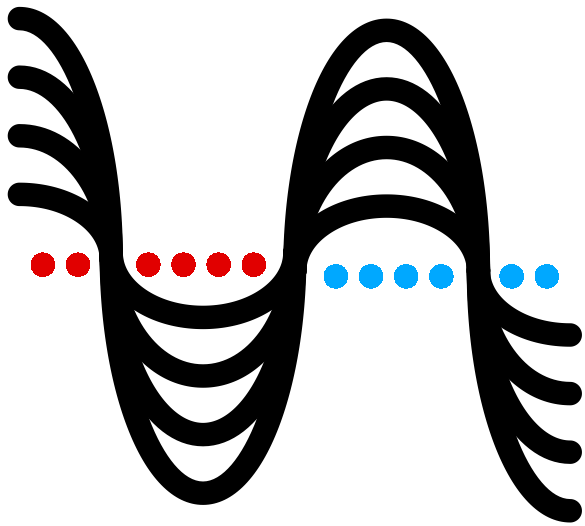 Construction
Construction
Fresh out of the box, my first impression was that this is a well made and handsome device: heavy duty metal case, nonslip feet, smooth turning dials, sturdy foot-switches and simple control layout. The control labels are too small to read while on the floor but no biggie once you memorize the layout. I assumed the image/patch would be displayed on the LCD but, instead, the LCD is reserved for tuner and bypass functions.
 Sound Quality
Sound Quality
According to Fishman, the Aura is designed to add a studio mic sound to an under saddle pickup. As wonderful as the under saddle piezo pickup is, it is not exactly natural in timbre or response. It's in the "acoustic" ball park but has definite electronic undertones: a tendency for harshness (piezo quack), increased sustain and electronic coloration. The Aura is supposed to simulate natural acoustic tone by blending an "image" of a mic'd acoustic guitar with the pickup signal. So does it work?
My point of reference is a live mix of my Neumann KM184 mic and the Cool Tubes pickup system on my Hirade TH90 and TH8SS classical guitars. Mixed 60/40 pickup and mic this combo is amazing through my Genz Benz acoustic guitar amp. I love this sound but it is a pain to carry around the extra gear to gigs and it feeds back easily at even moderate volume. The Aura can be cranked louder than a real mic/pickup blend and, of course, the Aura is easier to transport than a mic and boom stand.
Although the Aura boasts 128 images, only 16 of them are for classical guitar. Luckily it has 16 additional user assignable patches. I promptly filled them with nylon string images from the Aura Gallery and spend days working through the images. Only a handful of the images sounded decent to my ears. I found the images sounded best mixed between 9:00 (25%) and 12:00 (50%) with the dry signal.
Even sparingly mixed, many of the stock images were overly bright with rolled off bass and lower mids. The best images were the ones I downloaded through the Aura Gallery III application, especially the Ramirez and Buscarino images. I was surprised there were no Takamine or Hirade nylon string images, especially given these are popular gig instruments among classical guitarists.
After days of knob twisting and auditioning through a Trace Acoustic TA50R and Genz Benz Shenandoah SHEN-CPK-8T I came to this conclusion: the Aura does not make a classical guitar with under saddle pickup sound like it is mic'd. It also doesn't sound as good as an actual mic/pickup blend. Nevertheless, the Aura does sound different than a bare pickup and, with care, can impart a more realistic timbre while nixing the dreaded piezo quack. The secret is to find an image patch with a timbre close to your guitar and mix it sparingly (less than 50%) with the dry signal. And herein lies the catch: there is a serious shortage of good classical guitar image patches.
Nylon String Image Patches
I don't know who created the classical guitar images but certainly not a skilled classical guitarist. The images were bright and scratchy, as if a rough fingernail or guitar pick was used. None of the images have the sweet round tone of a classical guitarist. And this bright scratchy timbre was consistent across the board from the cheap Yamaha images to the high end concert guitars. The resulting mix of dry pickup and image sounded more like a jazz or Bossa nova player on nylon string mic'd with a vocal mic (upper mid EQ bump). Of course, finger style jazz players love that tone and it certainly has its place. But I'd be happy with just one great image created with Christopher Parkening or Pepe Romero tone! Please Fishman entice Chris or Pepe into your studio...
Other Features
One of the most attractive things about the Aura is it sports on board level, 3-band EQ, compression and feedback control. So even with the acoustic image feature disabled the Aura makes for a fine preamp and direct box (XLR and phone jack output).
I found the EQ implementation very useful and carefully focused towards the needs of acoustic guitarists. The range of adjustment leans towards fine increments so even a 90 degree knob rotation doesn't make a radical difference. These controls are designed for gentle tweaks and not extreme changes of tonal character.
And what a great one-knob implementation of compression. The goal is to sound natural so, again, range of adjustment leans towards fine increments. Set from 10:00 to 12:00 just evens up your attack enough to sound smooth without killing off accents or dynamics. You can't really screw it up unless cranked to the extreme position.
The feedback feature works okay and I like the ability to notch out multiple tones. However, it can be slow scanning and zeroing in on individual feedback tones. I'm faster manually dialing them out with the notch filters on my Trace Acoustic amps.
For three bills, I'd be a lot happier if Fishman included 16 or so nice hall and room reverb patches. It's a PITA to jack in another device just for a little reverb.
Power Supply
I have never liked relying on batteries for gigs and Fishman should have included a wall wart for the 3 benjamins they squeeze out of ya. Better yet, allow the use of phantom power as the majority of acoustic guitarists jack into acoustic guitar amps or mixing boards with phantom power.
Tuner
The Aura has a built-in tuner engaged via dedicated foots witch. Readout appears on a bright and easy to read 1990s style alphanumeric display. Sadly, tuner performance is mediocre, suffering regular misreads of my classical guitars. The tuner built into my Cool Tubes preamp is faster and nearly 100% reliable. Oddly this tuner works better with steel-string guitars so I assume Fishman didn't test it with nylon strings. I don't care about the tuner since all my preamps have better tuners, but a modern LCD with patch ID and ability to save user settings (e.g., fav image, EQ, compression) would be nice. Also, wish the foots witch could be reprogramed for other functions, e.g., bypass or stepping through image patches.
 RFI Resistance
RFI Resistance
I live and work in a city full of radio and TV transmitting towers. Cheap pedals, amps and mixing boards act like radio receivers and it ain't cool to have classic rock stations randomly interrupting sets or tracks. I am happy to say the Aura is well shielded and reasonably immune to RFI.
 Final Blurb
Final Blurb
The Aura Spectrum D.I. is not perfect but is a well made and designed pedal: tough as nails, handsome and sporting useful features even without the blended images.
The concept of blending samples of mic'd acoustic guitars is revolutionary and full of promise. Unfortunately, image quality and selection for classical guitar are poor compared to those for the steel-string acoustic. Image selections revolve around differences in wood response and timbre. And, yes, a cedar top does sound different than a spruce top. However, Fishman missed the most fundamental and pronounced aspect of tone production: the touch of the human finger. I would rather have a silky toned artist like Christopher Parkening or Manuel Barrueco create an Aura image on a plywood guitar than one from some random dude scratching around on a $25,000 Fleta with a guitar pick...
This product is optimized for acoustic steel-string players with a nod to the gigging classical guitarist. Fishman could make the Aura into a killer processor-preamp for all acoustic guitarists with the addition of better nylon string images, illumination of control and a bigger LCD with patch ID and ability to save user settings. Maybe someday Pepe will drop by the Fishman studio with his Fleta and record an image. I really wanted to love the Aura Spectrum D.I. but will have to settle for the friend zone.
Summer 2018 Update: Hoping to check for classical guitar patch updates, I found the Aura Gallery III app incompatible with Mac OS 10.12 (and likely 10.13). The Aura Gallery III app hasn't been updated since 2016 so you need a older Mac with a legacy OS (before 2016) to install updates.
Help support this site by purchasing the Aura from Amazon.
 Specifications
Specifications
• Aura® Acoustic Imaging
• 128 pre-loaded Images for use with acoustic instruments (mostly guitars)
• Instrument Preamp with Balanced XLR D.I. out
• Volume, Blend, and Image Select controls
• Three band EQ
• One-knob compressor
• Automatic anti-feedback with up to 3 notches
• Built-in chromatic tuner with bypass/mute
• 16 user-configurable Image locations
• USB interface for Image downloading from
• Aura Image Gallery (software included)
• Feedback-fighting Phase switch
• Automatic D.I. Ground Lift
• 9-Volt Battery or optional adapter operation
AUDIO I/O:
1/4" mono input & output w/input trim control
Balanced XLR D.I.
1/4" effects loop
24-bit A/D/A conversion
PROCESSOR:
32 bit processing
MATERIAL:
All-metal construction
DIMENSIONS:
5.6"L x 5.25"W x 2.1"H
POWER:
9-Volt battery or optional adapter power
BATTERY LIFE:
20 hours
11/01/2012 | Revised 08/12/2018